INDEX
- English
- 日本語
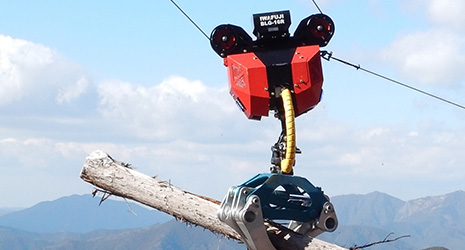
AI-equipped overhead machine for automatic timber collection - English
- 日本語

Forwarder during unmanned unloading work
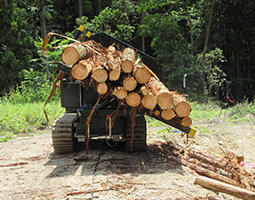
Unmanned freight forwarder transporting timber 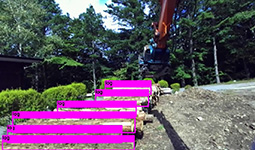
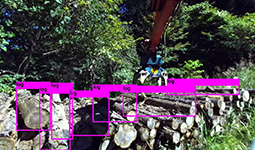
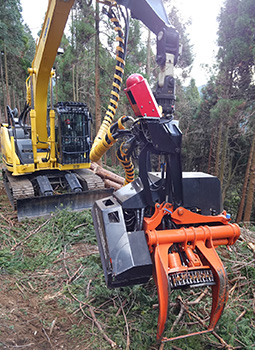
AI image recognition technology enables quick and easy survey and collection of timber
July 2021
Smart Forestry

Japan is promoting “smart forestry” that can facilitate safer and more efficient timber production through advanced technology.

Japan is blessed with abundant forest resources, with about 67% of the land covered in forests. However, because most of the forest is steep and complex terrain, there are many challenges in forest management and administration. For example, it is difficult to use large machinery to maintain forests growing on slopes, so forestry workers have to fell trees and cut branches manually, which has low labor productivity. There is also a lack of progress recruiting young people to forestry, while current workers are becoming older and older.
“Smart forestry” is a measure to try to overcome those challenges so as to maintain and utilize the forest resources with which Japan is blessed. According to the Forestry Agency of the Japanese Government, smart forestry uses geospatial information, ICT, and other advanced technologies to considerably improve operational productivity and safety, as well as facilitate advanced timber production that meets demand.
The Forestry Agency has been implementing “practical measures for smart forestry” in twelve areas with planted forests of cedar, cypress and other trees in places like Nagano, Ishikawa and Kumamoto Prefectures since fiscal 2018 as a way to promote smart forestry. As detailed below, various technologies to support smart forestry are being demonstrated in those areas.

Lasers, drones and smartphones
Previously, forestry workers would have to venture into the forests in person and conduct measurements in order to gather information about the forest resources, including the types and height of trees, which would take both manpower and time. Now, in order to conserve manpower, it has become possible to obtain such information more easily and quickly by introducing the measures of laser measuring from aircraft and analyzing images taken by drones.
A timber inspection system using smartphones has also been implemented. The system only requires photographs of cut logs in order to analyze information such as number of logs and log diameter using AI image recognition technology, enabling quick and easy survey and collection. This system also reduces labor significantly compared to conventional inspections that require forestry workers to count and measure.



Grasping consumer needs
In the past, it was difficult to quickly supply consumers with the timber they need due to insufficient sharing of information such as “what wood consumers want” and “where and how much wood is produced.” Now, cloud management of data gathered through ICT and other technologies to make supply and demand matching smoother has facilitated better sharing of forest information among forestry workers. Thanks to this, timber supply has sped up. For example, it used to be that timber logged in the forest was temporarily routed through a “marketplace” for timber before it was supplied to the sawmill, but advance information about demand and needs has made it easier to transport timber directly from the forest to the sawmill.
Moreover, Japan is seeing the gradual introduction of remote-controlled vehicles that can cut and transport trees on sloping terrain which construction machines cannot reach and of machines that can collect timber automatically using AI image identification of logged timber. Moreover, “forwarders” (vehicles for collecting timber) that enable unmanned self-driving timber transportation with the help of guidance sensors along the path are being developed.
New timber tree species
In addition to this development of advanced forestry technologies, Japan is researching, developing and popularizing new timber tree species. Special efforts are being made to popularize species that grow quickly. One issue is that cedar and cypress, which make up the large part of Japan’s planted forests, require a long time, fifty years or so on average, from planting to logging. As such, research is being conducted on ways to cultivate new types of trees, such as bead tree (Melia azedarach) and Chinese fir (Cunninghamia lanceolata), that can be logged after twenty to thirty years, and trial planting has started in several locations.
Innovations such as those mentioned above are expected to help in overcoming the various challenges Japan’s forestry faces, while also enhancing the possibilities of Japanese forest resources further in the future.

